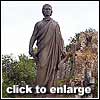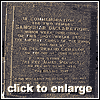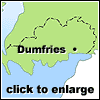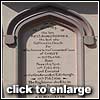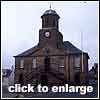
|
The Covenanters - Rev. James Renwick Preacher of the Covenant
By Brian Orr Have a question? Click Here to go to Brian's own Discussion Board!
Despite this loss at a critical time in his young life James managed to graduate from the University of Edinburgh. Having been brought up in a Christian family he was for a time confused and uncertain where his destiny lay. The turning point was on July 27, 1681, when he was at the Mercat Cross and witnessed the execution of Donald Cargill. Here he saw and heard a brave Donald Cargill declare his faith before execution: Later, Cargill's head and hands were hacked off and positioned above the Netherbow Gate as was the custom for Covenanting ministers. Renwick resolved that he would take up the ways of Cargill and his ilk: Soon he was in contact with the Societies, an eager advocate to do battle against tyranny. Renwick was sent to Holland, Rotterdam, Groenigen and Leeuwarden to complete his studies as a preacher and at 21 years of age he was ordained.
Renwick was quickly recognised not only as a fervent believer but a fluent and gracious preacher well able to get his point across to the crowds who came to listen to him. His first conventicle was at Darmead, in the parish of Cambusnethan, Lanarkshire in November, 1683, where he preached from the text of the Book of Isiah that Donald Cargill had used at his last gathering. People came from up to 16 miles to hear him, thus began for Renwick four years of ministry before he too was cut down by his persecutors. Into that short life he crammed awe inspiring deeds. Constantly preaching, he baptised some 600 children in his first year and roamed far and wide to preach at conventicles. The government saw that the Covenanters had a new leader and so began another cycle of repression and persecution of notable figures including Sir Hew Campbell of Cessnock who was sent to the Bass Rock prison. Captain John Paton of Fenwick was taken and hung in Edinburgh on May 9, 1684 despite the intervention of General Tam Dalyell. In general, there was an increase in demands to take Oaths of Loyalty enforced by the presence of troops and liability to heavy fines. It was against this background that James Renwick issued his Apologetical Declaration on October 28, 1684 defending his creed and supporters against many slanders that had been made and threatening death to spies and collaborators. The Declaration was posted by fixing on church doors.
So began "The Killing Time." Renwick was not a sturdy man by any means, being rather delicate and fragile. Thus the excessive travel, night wanderings, broken sleep and irregular diet were soon to catch up with him and show itself in consumption Despite poor health, he persevered in preaching at conventicles and had his share of escapes from capture. One such occasion was in July, 1684, near Dungavel when he and three companions were suprised by about twenty troopers. His companions were captured but Renwick drove his horse pell mell towards the crown of a hill where, just before the crest, he threw himself into a hollow in the heather. He fully expected his pursuers to find him but there he lay until sunset when he was able to make his way to a friendly farm about four miles away. A traditional tale of Renwick is that of travelling to a conventicle in Galloway and putting up the night before at an Inn at Newton Stewart. The imminence of the gathering was known to the authorities and a troop of dragoons had been despatched to search it out. The commanding officer of the troop, who some say was lost, arrived at the Inn and sought shelter for the night but, it being early evening, he then asked if there was company to be had for conversation to pass the time away.
On another occasion Renwick travelled to the village of Balmaclellan in Galloway where he was to preach at a conventicle in a secret place. On the morning the sky was clouded and and heavy showers were falling in the hills swelling the hill streams and the rivers into which they flowed. Even so, the people gathered for the conventicle only to be found by troopers as they began to pray. Renwick and two companions, John McMillan and David Ferguson, fled towards the River Ken intending to cross and go to friends in the Parish of Penninghame. On reaching the river they found it in flood and decided to stop and pray, which they did in the shelter of some bushes. On rising from their knees and about to enter the surging river they were astonished to see pursuing troopers landing on the other side of the river. It seems that the troopers had ridden past the men in the gloom and hurried across the river before it became impassable; whereas if the three had not stopped for prayer they might well have been caught in midstream.
McMillan and Ferguson left Renwick at the river and returned whence they came, Renwick made his way downstream and sought cover for the night, eventually settling on the rock to sleep. He was, however, wakened by the sound of singing and traced it to a shepherd's cottage further down the valley. The owner of the cottage was a James McCulloch, who was not a friend of the Covenanters but imbued with drink he welcomed Renwick into the home. McCulloch was suspicious but his wife, a God fearing women, drew Renwick to one side and made him comfortable in an adjoining room. Awakening early he searched for his clothes without success but Mrs McCulloch had taken them to dry them out and gave him some of her husband's old clothing in the meantime - which was to save his life. Mr McCulloch had departed the cottage early to take sheep to safer pastures following the night's downpour. Renwick took the opportunity to walk outside and enjoy the air. In passing out of the cottage he threw across his shoulder an old plaid and was joined by one of the dogs. Thus attired and relaxed enjoying the morning air, he suddenly found himself surrounded by troopers who asked if he was the master of the cottage. Truthfully Renwick said he was not and told them where he might be found, after some conversation about rebels and fugitives the troopers concluded that the river in full flood would have prevented fugitives getting across and they departed leaving a thankful Renwick delivered to safety twice in 24 hours.
"...any intelligence with him by word, writ or message ....under pain of being esteemed art and part with him in the crimes aforesaid..." It is a measure of the respect that the populace had for him that he eluded capture for over three years after the proclamation. On May 28, 1685 Renwick and an entourage of some 200 men rode into Sanquhar, as did his predecessor Richard Cameron five years before, to issue a Declaration that was similar in content. He then spent some time in the North of England preaching wherever opportunity afforded itself before returning to Scotland in December, 1686, to take part in the General Meeting of the United Societies. But the time finally came when in December, 1687, he was overheard in Edinburgh and recognised. He fled from the home of a friend in Castle Hill but was seized and handed over to the City Guard who despatched him to prison.
Although Renwick was the last of the preachers to die for his faith, the very last Covenanter to be martyred was a 16 year-old youth , George Boyd, shot down by a trooper in an Ayrshire field in the summer of 1688.
Meet the Author, Brian Orr, Researcher with The Guild of One Name Studies
Back to The Covenanters, Main Page
Part One: The Covenanters: Who Were They?
|
Thursday, December 26th, 2019
Attention visitors: Tartans.com is back. Please note that this is a snapshot of the site as it existed nearly 20 years ago and you may encounter broken links; we are still combing through the site and correcting those as we find them. Please also note that some sections are currently not functional, primarily the discussion forums/clan chat boards.
|
** HOME - First Time Visitors - Glossary - - Contact Us ** Awards | Bibliography | Clan Calendar | Clan Chat | Clan Finder | History | Famous Scots | Genealogy | Great Hall of the Clans | Links | News and Features | Scots on the Net | Search | Site Map The Gathering of the Clans
Copyright 1995- Tartans.com - All Rights Reserved. |
